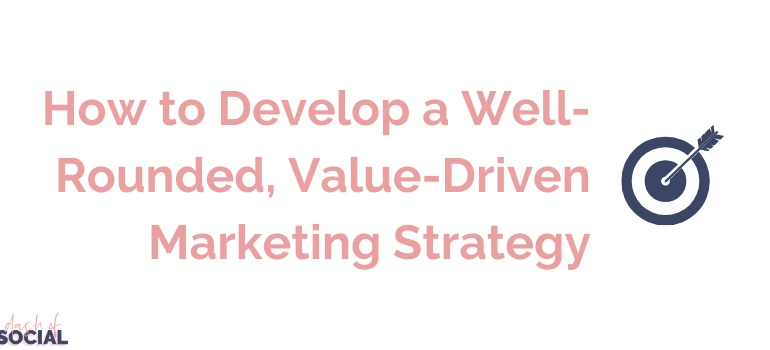
How to Develop a Well-Rounded, Value-Driven Marketing Strategy
Do you thoughtfully develop your marketing strategy, or do you just “go with the flow” and do the things that you think you should be doing without having no clear plan in place? If it’s the latter, that needs to change–and here’s why.
When you execute marketing initiatives in the spur of the moment rather than thinking ahead, you most likely…
- Focus on only one marketing outlet (i.e. social media) because you don’t have time to think about others
- Neglect to think about what your audience really wants to know
- Throw spaghetti at the wall and hope that it sticks–doing things without even thinking if they’re actually going to work
And none of those are going to work in your favor. Instead of doing things last minute, take some time to develop a well-rounded, value-driven marketing strategy to ensure you’re getting the best results as possible for your efforts.
Follow the guide below to know which outlets to focus on for your marketing and how you should be using them.
Social Media
If you are currently doing any marketing, I’m sure that social media is at the top of it. However, I want you to ask yourself this: Am I limiting myself to just one social media channel, or am I using a variety of them?
The reason why it’s important to think about that question is that too many business owners are putting all of their eggs into one basket by using only one social media channel (i.e. Instagram). By not using a variety, not only are you limiting yourself to the amount of people in your target market that you can reach but you’re also being super risky–and not in a good way! If you spend all of your time building your business on that one platform and suddenly your account gets hacked or shut down, what will happen to your business? Will it still move on as normal, or will your business be affected because you pigeonholed yourself?
To prevent this from happening, spread your efforts across multiple platforms as long as your audience exists on those platforms. You don’t want to be using a social media channel where your ideal client or customer doesn’t even hang out because that would be a waste of time. If your target market doesn’t use Twitter, don’t use Twitter.
Here’s what you can incorporate into your social media strategy across multiple platforms:
- Publishing value-driven content. Are you writing posts that resonate with your audience and solve a problem they’re facing? Do your followers read your post and think to themselves, “YES! This is just what I was looking for,” when scrolling through your feed?
- Engaging with your audience. The days of “build it and they will come” are over–meaning, you can write really great content, but that doesn’t necessarily mean that people will instantly come flocking to you. You need to go out and build relationships with your ideal clients first. Spend at least 30 minutes each day commenting on Instagram posts, engaging in relevant Facebook and LinkedIn groups, and striking conversations with your audience.
- Incorporating video and personal content. Any content that shows the face of you, the business owner, will almost always outperform content that is a stock photo, text graphic, etc. Get comfortable with showing your face more often on camera, especially through video. This will build the know / like / trust factor with your audience, and people do business with people that they know / like / trust.
It’s also important to note that you don’t need to post every single day. Post at a frequency that feels good to you–whether that’s once per week, three times per week, or even five times per week–as long as you’re consistent. It’s the consistency that matters most.
Once you implement these tactics, review your analytics at least monthly to see which strategies are performing the best so you know what to do moving forward.
FREE RESOURCE: Social Media Content Calendar Template
Email Marketing
Do you fall in the category of: “I have an email list but rarely use it”? Many people do. They may have a simple opt-in form on their site that allows website visitors to sign up for their email list for updates, or they may offer a freebie to get people on their list–but then they do nothing with those subscribers.
So many people think that email marketing is dead, but here’s the thing: they couldn’t be more wrong. Unlike social media, email doesn’t really have an “algorithm” besides the filtering of where your emails will land in your subscribers’ inbox. People check their email daily, and usually multiple times per day, which means that this is a solid opportunity for you to get seen in front of your ideal client or customer. In fact, for every $1 you spend on email marketing, you can expect an average return of $42 (source: DMA).
In that case, why wouldn’t you want to use email marketing? You can leverage email marketing to:
- Send abandoned cart emails for the customers who put items in their cart and then leave them, therefore encouraging more people to go through with their purchase.
- Share updates with your client or customer base on promotions, new product or service releases, company news, and more.
- Give helpful tips and advice that will solve a problem your subscribers are facing.
Just remember that to be able to send emails, you have to actually focus on building your email list, which means you can do so by:
- Offering people a coupon code or discount for your products if they join your email list
- Sharing a free resource if people join your email list
For the frequency of your newsletters, don’t feel like you have to send them often, unless you’d like to, of course. Monthly is a common frequency, but you may find that you will send more depending on what you have going on in your business (Black Friday sales, product releases, etc.)
Blogging
Just like people think email marketing is dead, they also think blogging is dead–but they’re wrong about that, too! There are two reasons why blogging is so fantastic:
- It drives people to your website, which will then convert them to becoming clients or customers.
- It positions you as an expert because you’re sharing free, valuable information on an important topic (just like what I’m doing with this blog post).
The best blog posts are the ones that directly solve a problem or struggle that your audience is facing, just like what is the case with most content. Here’s a pro tip: every time a client or customer mentions something like that to you, write it down. You can easily follow that list and turn each point into a full blog post.
Common blog post topics include:
- How Tos
- Tips
- Stories
- Features
- Lessons
You only need to publish one blog post per month for SEO purposes, but if you would like to do more than that, by all means go for it. Just make sure to promote the blog post to your email list and across social media to drive people to your website!
Public Relations (PR)
If you’ve ever wanted to be a guest on a podcast or get interviewed for a publication, this is where public relations (PR) comes in. Similar to the benefits of blogging, PR is incredible for three reasons:
- It gets you seen in front of an audience much larger than your own, whom you never would’ve reached before, and shares information about your products and services.
- It links back to your website, which improves your SEO.
- It positions you as an expert because you’re sharing free, valuable information on an important topic that immediately improves the reader or listener’s life.
Getting featured in other places is easier than you think. It mainly involves researching various publications to find the ones that have a similar audience to yours and pitching yourself for an interesting topic that would provide value to the audience. It’ll take some time before you get featured somewhere, so don’t get discouraged if it doesn’t happen right away. You’ll need to pitch yourself often in order to make this happen.
Networking
Some might not consider networking to fall under marketing, but I do. Networking is marketing yourself–you’re sharing who you are, what you do, and how you help people to the other person or entire group you’re networking with. Despite how overused the phrase “your network is your net worth” may be, it’s true. The people that you know can easily lead you to making more money and making a bigger impact through your business.
Between 70%-75% of our clients each year come from Facebook groups alone, which is absolutely a form of networking. The people that you’re networking with might not hire you or purchase your products directly, but they will definitely refer you to their circle.
You can network through:
- Online communities (i.e. Facebook and LinkedIn groups)
- Networking or business groups (i.e. Chamber of Commerce)
- 1:1 calls or meetings (i.e. setting up a call with someone)
Make sure to network often, as the more you do it, the more benefits it will bring you. My personal goal is to set up or attend at least one networking event or call each month.
FREE RESOURCE: Grow Your Business Through Facebook Groups
Although there are many more marketing initiatives and outlets to consider and pursue, in my personal opinion, these are the ones that make the biggest impact and make the most sense for you to do if you’re managing your own marketing as a business owner.
Here’s to developing and executing a well-rounded, value-driven marketing strategy for your business! If you ever need additional support, learn about our marketing strategy services.
